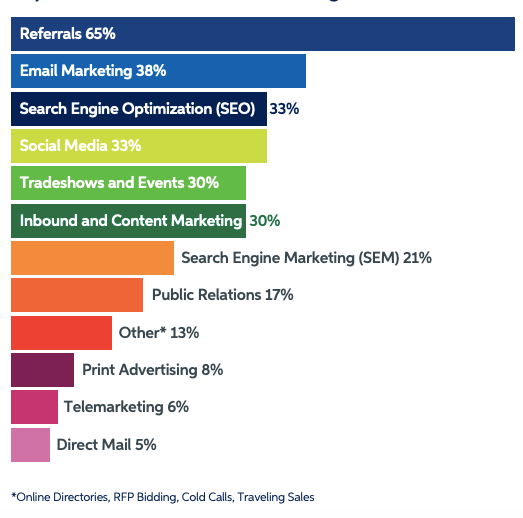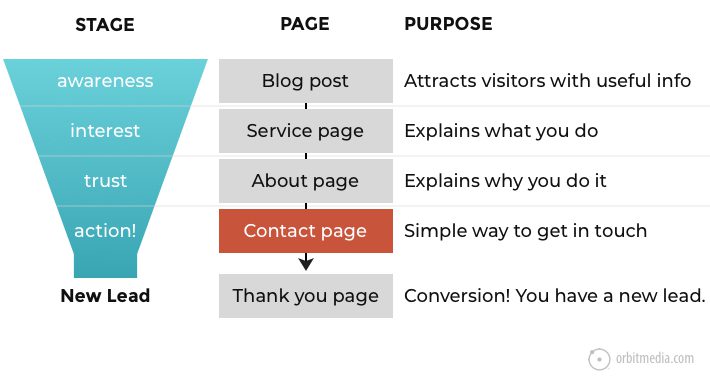For most businesses, generating a steady stream of new leads is imperative for acquiring new customers and growing revenue. With that in mind, optimizing your website to generate leads is an obvious no-brainer. But unfortunately, it’s not as simple as throwing a “Get a Quote” or “Learn More” button on your home page and watching the leads pour in.
Instead, marketers and web designers need to take a more strategic approach. In this post, we’ll review some quick ways and tools that actually work to optimize your website for lead generation.
To understand how to optimize our website, we’ll have to first gain a basic understanding of the lead generation process.
What components are at play when a casual website visitor turns into a lead?
The lead generation process typically starts when a website visitor clicks on a call-to-action (CTA) located on one of your site pages or blog posts. That CTA leads them to a landing page, which includes a form used to collect the visitor’s contact information. Once the visitor fills out and submits the form, they are then led to a thank-you or confirmation page and sent a confirmation email.
Now that we’ve gone over the basics of lead generation, we can get down to the details.
Key Takeaways:
- Websites are a make or break component to effective lead generation
- Your website should focus on building credibility and trust with visitors
- Lead generating websites take careful planning, expertise, and lots of testing
Why is Your Website Critical to Lead Generation?
Your website is a huge factor in the perceived credibility of your business and your ability to generate leads. Within seconds of their first visit, prospective buyers equate a poor website to poor quality, which may quickly eliminate your company from consideration.
An outdated, poorly designed, or overly complex website puts your business at risk. How can you improve your website so you can quickly build credibility while attracting prospective customers and generating more leads? Let’s look at three important factors to successful lead-generating websites: Content, Design, and Analytics.
Website Content for Lead Generation
Well researched and written web content is the foundation of a high-performing website. Everything should be focused on building trust with your target audience via carefully organized content that talks directly to their most pressing problems and challenges.
- Clear messaging – Hiding behind technical language or convoluted marketing jargon can be confusing for potential visitors, so get straight to the point and keep it simple.
- Blog – Take the time to create informative content (articles, guides, lists, how-to’s) on a regular basis. Be sure to base topics on the most relevant questions and challenges facing prospective customers!
- Content Types – Carefully choose content types based on your ideal buyer’s preferences. Content like ebooks, guides, lists, comparisons, infographics, and videos can be very effective. The best content type varies by industry, gender, and age, so make sure you take the time to research and understand your buyer personas.
- Industry-Specific Testimonials – Provide real-life examples as case studies to demonstrate successful work and results to prospective clients. Make sure to include common challenges and pains faced by the customer, and how your product or service helped overcome them.
- Be Unique – You want to be at the top of people’s minds, so be unique and memorable. Exceptional content can take the form of an intuitive search feature, online tools, resource guides, infographics, or a series of videos.

Website Design for Lead Generation
Web design encompasses many different skills and disciplines in the production and maintenance of websites. The different areas of web design include web graphic design; user interface design (UI design); authoring, including standardized code and proprietary software; user experience design (UX design); and search engine optimization. Depending on the size and complexity of your project, the following components should be considered a top priority to building a lead generation website.
- Focus on User Experience – User experience describes how people feel when navigating a website, using a mobile app or otherwise interacting with a company’s digital products or services. There are many elements that contribute to designing for exceptional user experiences, such as user research and usability testing.
- Navigation – Good website navigation is always designed with the user in mind. It uses clear, easy-to-understand language, and links to the most important pages. It makes use of ample white space, color changes, or other design techniques to clearly separate itself from the main site content.
- Mobile Responsive – A responsive website is one that changes based on the screen size of the device. Responsive websites react with the user in mind to enhance usability on all devices, especially smartphones.
- Landing Pages – Plan out a buyer’s journey from the home page of your website through the point of conversion (form submittal) or purchase. Prepare a clear path with quality information to help them make a decision as they pass through each step of their research during the buying process.
- WebForms – Studies show that there is a direct correlation between the length of web forms and their rate of completion. Stick to the basics at first, followed by more details as buyers move through the buying process.
- Subscription Forms – Building a quality email list is a critical tool for new prospects and existing customers. Make it easy for visitors to subscribe to blog article updates, news updates, new content offers, webinars, and more.
- SEO – SEO stands for search engine optimization, which is a set of practices designed to improve the appearance and positioning of web pages in organic search results. Because organic search is the most prominent way for people to discover and access online content, a good SEO strategy is essential for improving the quality and quantity of traffic to your website.
- Social Sharing Tools – By adding sharing buttons to your website, your visitors can quickly share helpful content while expanding your reach and building awareness for your brand!
- Be Accessible – Publish your contact information so that it’s easy to find. Contact forms, location finders, phone numbers, email addresses, and live chat are effective engagement tools for your customers to easily get in touch.

Website Analytics for Lead Generation
Web analytics is the measurement and analysis of data to understand user behavior across your web pages. Businesses use web analytics platforms (i.e. Google Analytics) to measure and benchmark site performance and analyze key performance indicators that drive their business. Some of the most common indicators are the number of visitors, average page views per session, session duration, bounce rate, conversion rates, and more.
- Web Analytics – Many businesses start with Google Analytics. It’s the most popular solution for web analytics with over 29 million websites using it. It’s free and robust enough for many small to medium-sized businesses. Using Google Analytics, you can understand which channels bring you website traffic and see a wide range of metrics. Other common tools for website analytics include Google Search Console, Heap, Statcounter, and others.
- Usability (UX) Analytics – Usability tools (i.e. Hotjar) are specialized tools that let businesses analyze what users do on a page. They record how people interact with the page and its elements, so an online marketing or product team can evaluate how different features are received. With these insights, businesses can then make changes to the page or user interface and see how those changes play out by measuring user behavior. Other common tools for usability analytics include Crazyegg, Smartlook, and others.
- SEO Tools & Analytics – If you use search engine optimization to attract traffic from search engines, you most certainly need a specialized SEO tool (Semrush, Ahrefs, Moz and others) in your web analytics tool stack. With most SEO analytics tools, you can identify trends that occur within your industry niche. It audits your on-page SEO and helps you optimize your pages or organic search. Some of the features offered by these platforms include keyword tools, website audit tools, position tracking tools, competitive analysis tools, backlink analysis tools, and more.
Other Resources:
- 63 Web Design Terms Every Marketer Should Know
- Google Ranking Factors in 2022
- How to Budget for Web Design and Development
- Understanding Web Core Vitals and UX
Successful Lead Generation Starts with a Solid Website Strategy
Whether you’re a new or established company, a well-designed and optimized website can help you build your brand, gain exposure and build a consistent lead generation pipeline. You’ll want to start with well-defined buyer personas to understand your buyers’ needs, challenges and much more. From there you want to create a Website Blueprint that includes your overall strategy from design to content and development.
Ready to reboot your website lead generation strategy? Get started with Shanahan Strategy.

